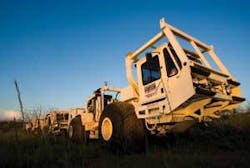Dawson Geophysical helping clients reduce finding, development costs
AN INTERVIEW WITH DAWSON GEOPHYSICAL’S STEVE JUMPER
EDITOR’S NOTE: Dawson Geophysical has been using ever-evolving technologies to help clients find oil and gas and combat production declines for 56 years. During this time, the company has participated in the transition from 2D to 3D seismic, while achieving steady, disciplined financial growth. Steve Jumper, Dawson’s president and CEO, recently took time from his schedule to talk with OGFJ.
OIL & GAS FINANCIAL JOURNAL: In February, you will be presenting at EnerCom’s Oil Service Conference in San Francisco. What’s changed in the seismic industry since you presented there last year? Talk to us about the evolution of seismic since the company was founded in 1952.
STEVE JUMPER: Since last year, our disciplined growth strategy and our steadfast commitment to our clients have paid strong dividends. We have added two new crews bringing our total to 15, maintaining our position as the largest geophysical company in the lower 48, as measured by the number of active crews. We increased channel count, a key metric in our growth, by approximately 20,000, with the deployment of a 10,000 channel crew and increased channel count on two existing crews to 9,500 and 7,500 channels respectively.
Since 1952, the industry has evolved far beyond what many had envisioned more than a half century ago. It is difficult to comprehend, much less compare, the technological advances in computers, electronics, surveying, energy sources, processing techniques, and data storage that have all contributed to the transition from 2D to 3D. As we look forward, all indications point toward an increased demand for seismic services and innovative solutions for a clearer image of the earth’s subsurface.
OGFJ: Why are seismic services so vital within the oil and natural gas industry?
JUMPER: Accelerating production declines in oil and natural gas fields in the continental United States are a painful reality that many operators are forced to confront. Coupled with rising rig rates and a tight labor market, companies are searching for a way to find more oil and natural gas while keeping their finding and development costs down.
At Dawson Geophysical, we work with our clients to achieve these goals. We understand the complex geology and use the most up-to-date technologies to cost-effectively identify oil and natural gas reserves. We work closely with our clients to ensure that we are adding value to their operations.
OGFJ: You added three new data acquisition crews in fiscal 2007. What considerations go into launching an additional data acquisition crew?
JUMPER: The data acquisition crews at Dawson Geophysical are the backbone of our company. They operate in every major basin throughout the continental United States. Upon completion of a project, they may be required to travel to new and different basins to begin the next project.
That said, there are a number of factors that must be considered before launching an additional crew. First, long-term visibility. Is there another project available to immediately redeploy a crew upon completion of their work? If not, are there shorter-term assignments to keep the crew busy? If the answer is no to each of these questions, the launch of a new crew may not be necessary. Crews that sit idle for several or more weeks are expensive. Therefore, we must have long-term visibility in both our order book and the industry trend.
An additional factor to consider before launching a data acquisition crew is the structure of contract terms of each project. Is the contract a term contract or a turnkey contract? From a financial and an operational perspective, we prefer a balanced portfolio of turnkey and term contracts.
Are there sufficient personnel to begin and complete each project? In today’s oil and gas sector, there is a shortage of qualified personnel. Aligning the appropriate personnel is critical and a factor that always must be considered when deciding to launch an additional crew.
OGFJ: What’s different about Dawson’s crews when it comes to seismic acquisition?
JUMPER: As I said earlier, these people are the backbone of our company. One of the key characteristics that separates Dawson Geophysical [from other companies] when it comes to seismic acquisition is our support structure.
We have created a support structure that we believe gives us a competitive advantage and quality assurance. We know the basins in which we operate. Our people understand the geology, the operational issues, and leverage the technologies that are required to identify oil and natural gas reservoirs. We provide all services necessary to complete a 3D survey, including survey design, planning, permitting, surveying, data processing, and technical support. This is what makes us different and has allowed us to succeed since 1952.
OGFJ: How many crews can the seismic industry support before it reaches saturation?
JUMPER: That’s an interesting question. Crew count is not the one and only measure of capacity within our industry. Channel count plays a huge factor and is an equally important metric. To give you a point of reference, in the early 1980s there were approximately 700 data acquisition crews operating less than 100,000 channels in the Lower 48. Today there are approximately 58 crews in the Lower 48 and we own 102,000 channels ourselves. So while the crew count has dropped dramatically since the high 25 years ago, the industry recording capacity has exploded. We may be nearing the point of reasonable balance as far as crew counts are concerned but the focus going forward will be channel count growth.
OGFJ: What exactly are channels and why are they so important?
JUMPER: As many of you know, channels are individual recording locations. I often like to make the comparison to pixels in a digital camera. Increased channel count helps in many ways –higher resolution images, longer offsets, wider azimuth for deeper targets, improved noise reduction, and increased productivity. Increase channel count really adds value to our services.
OGFJ: How long does it take to set up and complete a seismic project?
JUMPER: As you can imagine, there are many factors that contribute to the length of time it takes to get a seismic project ready for a crew. These factors include the shape of the survey, the size of it, the terrain, the geographic location, time of year, land access permits, and general logistical concerns. The time necessary can range from as little as a few weeks to years, with each being the exception not the rule. Generally speaking, it is in terms of months to set up. Many times it takes less time for a crew to actually acquire the survey than to get the survey ready for a crew.
OGFJ: How closely tied is your business to short-term shifts in oil and natural gas prices?
JUMPER: While short-term shifts in oil and natural gas prices may impact some segments of the oil service sector, the impact on the seismic industry and Dawson Geophysical has been minimal. Seismic exploration activity is generally considered a long-term proposition. Projects can often take several months or more to prepare and complete. In fact, some of the projects we work on today will be drilled some time next year.
Due to the size and scale of our projects, it is more difficult to start and stop seismic operations than other oilfield service activities. As a result, many oil and natural gas producers often chose to ride through any short-term shifts in oil and natural gas prices.
OGFJ: Without naming clients, please provide our readers with some case studies of how you are able to help your clients lower their finding and development costs?
JUMPER: It is difficult to quantify “lowering finding costs” because we never know how many dry holes or poor wells were avoided when seismic data are incorporated into the exploration and development programs. On the flip side, we know of several instances where the factors contributing to dry holes or marginal wells have become obvious upon the completion of a 3D seismic survey.
OGFJ: Dawson Geophysical is the largest seismic provider in the United States, excluding Alaska. Does the company have any plans to expand internationally?
JUMPER: At this point, we’ll continue to focus on the Lower 48. This is where we’ve operated since 1952. It’s where our core competency, our competitive advantage, and our growth opportunities are best realized.
OGFJ: In November, DWSN reported record revenues and earnings. The stock has run from $37 to nearly $80 in 2007. What do you see for Dawson Geophysical in 2008?
JUMPER: As far as the stock price is concerned, I’ll leave that to the professionals on Wall Street. There are way too many factors beyond our control that impact stock price. That said, I will say this, 2008 looks and feels like a strong year based on the opportunities we foresee.
Our order book is strong and our relationships with our clients have never been better. Our morale is high, our equipment is in good condition, and our balance sheet strong. We will stay focused on helping our clients find oil and gas, work each day to become more efficient, deliver a better product and do everything in our power to add shareholder value. As Greg Barnett said at the EnerCom Conference in Denver last August, “We stick to what we know, then we stick it to what we know.” That is what we can control. I leave stock price predictions to people smarter than me.
OGFJ: How is the reprocessing of older data using new seismic logarithms an effective tool for the geologist when doing their early exploration evaluation? How does Dawson help in this effort?
JUMPER: Our processing group has been very involved in the reprocessing of legacy data sets. They utilize new techniques and processes to extract every bit of information from the data as possible and create images unrealized in legacy data sets. Often times, reprocessing leads to the acquisition of a new survey with more channels in order to fully realize the benefits of new processing techniques.
OGFJ: Regarding your professional staff, can you talk a little bit about their strength, character, and technological skills?
JUMPER: Easiest question. All staff in every department are top shelf. Great character, tremendous strengths, technical leaders. Better yet, great folks. They are Dawson Geophysical. I am a huge football fan and I have heard coaches talk about players’ abilities; their speed, strength, etc. But the players they most desire are the players that have “it” –that special quality that leads to top performance in all situations. Players that get it done. Our people have “it.”
OGFJ: Thanks for taking the time to talk with us.
null



